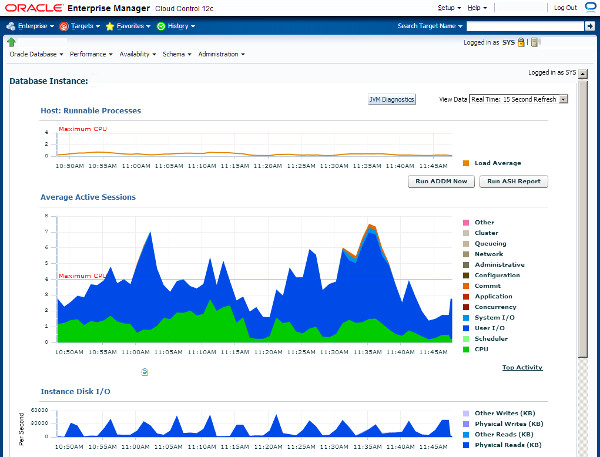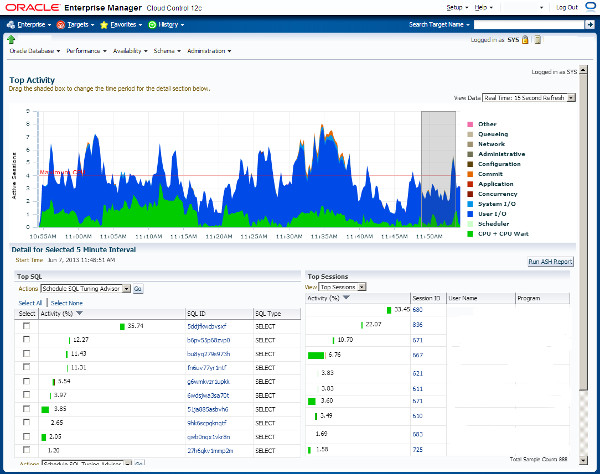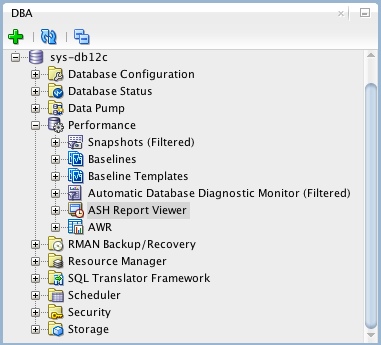[转帖]Active Session History (ASH)
- Introduction
- V$ACTIVE_SESSION_HISTORY
- DBA_HIST_ACTIVE_SESS_HISTORY
- Enterprise Manager Performance Pages
- ASH Report
- SQL Developer and ASH Reports
- ASH Viewer
Related articles.
- Automatic Workload Repository (AWR) in Oracle Database 10g
- AWR Baseline Enhancements in Oracle Database 11g Release 1
- Automatic Database Diagnostic Monitor (ADDM) in Oracle Database 10g
- Active Session History (ASH) Analytics in Oracle Enterprise Manager Cloud Control 12c
Introduction
For a long time DBAs have been encouraged to use variations on the YAPP method of performance tuning, which focuses on wait event monitoring, rather than hit ratios. Tools like Statspack, AWR, ADDM and SQL Trace are all very useful for gathering wait event information during tuning, but they tend to focus on looking back at what has happened, rather than what is currently happening. The [G]V$ dynamic performance views provide masses of real-time information, but it can be difficult for beginners and experienced people alike to make good use of this information.
Oracle 10g introduced the Active Session History (ASH) as part of the Diagnostics and Tuning Pack. It samples information from the [G]V$ views allowing you to see current and historical information about active sessions on the database.
Being part of the Diagnostics and Tuning Pack means ASH is only available as a paid option on top of Oracle Database Enterprise Edition.
V$ACTIVE_SESSION_HISTORY
Samples of wait event information are taken once per second and made available using the V$ACTIVE_SESSION_HISTORY view. An active session is one that is waiting on CPU or any event that does not belong to the "Idle" wait class at the time of the sample. The sample information is written to a circular buffer in the SGA, so the greater the database activity, the less time the information will remain available for.
The V$ACTIVE_SESSION_HISTORY view is essentially a fact table, which can be linked to a number of dimensions to provide statistics specific to a variety of things including SQL statements, execution plans, objects, wait events, sessions, modules, actions, client identifiers, services and consumer groups etc. This makes it an incredibly flexible way of identifying what active sessions are doing, or have done. For example, if I wanted to see the main activity on the database for the last 5 minutes, I could use the following query.
SELECT NVL(a.event, 'ON CPU') AS event,
COUNT(*) AS total_wait_time
FROM v$active_session_history a
WHERE a.sample_time > SYSDATE - 5/(24*60) -- 5 mins
GROUP BY a.event
ORDER BY total_wait_time DESC; EVENT TOTAL_WAIT_TIME
---------------------------------------------------------------- ---------------
db file sequential read 750
log file parallel write 43
log file sync 42
db file parallel read 32
control file sequential read 22
ON CPU 21
db file parallel write 21
log file switch (private strand flush incomplete) 8
Disk file operations I/O 1
control file parallel write 1
buffer busy waits 1 11 rows selected. SQL>
Notice how the count of the samples is used to determine the time waited, not the WAIT_TIME or TIME_WAITED columns. Why is this done? Remember, this is sample data, so wait times are accumulating with each sample. Merely summing them will give a falsely high value. To explain this, imagine simplified case where a single session is waiting on "db file sequential read" for 5 seconds. That means we would have 5 samples, that may look like this.
EVENT SAMPLE_ID TIME_SEC
======================= ========= ========
db file sequential read 1 1
db file sequential read 2 2
db file sequential read 3 3
db file sequential read 4 4
db file sequential read 5 5
We know the total wait time is 5 seconds. If we count the number of samples, we get 5, which we equate to 5 seconds. If we sum the time for all 5 samples get 15 seconds.
The time columns in the ASH data are a little more complicated than they first appear, so check the documentation when using them. Incorrect usage of these columns is probably the most common mistake people make when using ASH views.
The fact ASH uses samples can of course mean certain bits of information slip through the net, but this is not really a problem. The chances are your main concerns will be those sessions or statements that are taking lots of time. The longer things take to run, the more samples they are likely to be picked up in. It is unlikely that anything of major concern will completely fail to register in the ASH views, but that doesn't mean you can ignore its limitations.
DBA_HIST_ACTIVE_SESS_HISTORY
To allow for historical access to the ASH data, one in ten samples are persisted to disk and made available using the DBA_HIST_ACTIVE_SESS_HISTORY view. So this is a sample of a sample. Using this view is similar to using the V$ACTIVE_SESSION_HISTORY view, but remember the sample time is now 10 seconds, so use (count*10) to measure time, rather than just the count.
SELECT NVL(a.event, 'ON CPU') AS event,
COUNT(*)*10 AS total_wait_time
FROM dba_hist_active_sess_history a
WHERE a.sample_time > SYSDATE - 1
GROUP BY a.event
ORDER BY total_wait_time DESC; EVENT TOTAL_WAIT_TIME
---------------------------------------------------------------- ---------------
db file sequential read 3860
ON CPU 1500
control file sequential read 990
direct path read temp 580
direct path read 560
log file parallel write 280
db file parallel write 270
Disk file operations I/O 240
log file switch completion 150
log file sync 130
db file parallel read 130
.
.
. 26 rows selected. SQL>
Enterprise Manager Performance Pages
Accessing the ASH information directly can be very useful, but there are a number of more efficient ways to get to some of this information. The performance pages of Enterprise Manager (Grid Control and Cloud Control) are fantastic. They are based on the ASH information, giving you easy access to real-time and historical performance information.
The following picture is an example of the Enterprise Manager performance home page.

An example of the Top activity page is shown below.

ASH Report
ASH reports can be displayed using Enterprise Manager, or generated from SQL*Plus. To manually generate them using SQL*Plus, run the following script, while logged in as a privileged user.
$ORACLE_HOME/rdbms/admin/ashrpt.sql
The script prompts you for the following details:
- Report Type: [ html | text ]
- Instance number: [all | n ] - On single instance databases, this defaults to "1". On RAC databases you can report on a specific instance number or "all" instances.
- Begin Time: The script describes the formats for this value. It can be an explicit date string or an offset of the current datetime. The default is -15 minutes.
- Duration: The number of minutes to report on. The default duration is (SYSDATE - begin_time).
- Report Name: A default name is provided. Change this if required.
The script produces either text or HTML output as requested. Examples of these are shown below.
Depending on the options selected, the ASH report scripts call one of several table functions from the DBMS_WORKLOAD_REPOSITORY package.
ASH_REPORT_TEXTASH_REPORT_HTMLASH_GLOBAL_REPORT_TEXTASH_GLOBAL_REPORT_HTML
SQL Developer and ASH Reports
If you are using SQL Developer 4 onward, you can view ASH reports directly from SQL Developer. If it is not already showing, open the DBA pane "View > DBA", expand the connection of interest, then expand the "Performance" node. The ASH reports are available from the "ASH Reports Viewer" node.

ASH Viewer
The ASH Viewer tool gives a graphical view of active session history data within the Oracle instance. Interestingly, it is supports Oracle 8i onward. In releases prior to Oracle 10g, or if you don't have a Diagnostic and Tuning Pack license, you can connect using the "Standard" connection and the tool will mimic the functionality of ASH. If you have the necessary licenses, you can make "Enterprise" connections, which use ASH to provide the data.
For more information see:
- Active Session History
- V$ACTIVE_SESSION_HISTORY
- DBA_HIST_ACTIVE_SESS_HISTORY
- Generating Active Session History Reports
- Automatic Workload Repository (AWR) in Oracle Database 10g
- AWR Baseline Enhancements in Oracle Database 11g Release 1
- Automatic Database Diagnostic Monitor (ADDM) in Oracle Database 10g
- Active Session History (ASH) Analytics in Oracle Enterprise Manager Cloud Control 12c
Hope this helps. Regards Tim...
[转帖]Active Session History (ASH)的更多相关文章
- Active Session History (ASH) Performed An Emergency Flush Messages In The Alert Log
Active Session History (ASH) Performed An Emergency Flush Messages In The Alert Log (文档 ID 1385872.1 ...
- Session History 属性和方法
History 接口允许操作浏览器的曾经在标签页或者框架里访问的会话历史记录. js通过window.history来访问和操作的,操作的范围是某个tab的会话历史记录. 这个tab打开后,tab内的 ...
- Design Doc: Session History for Out-of-Process iframes
Design Doc: Session History for Out-of-Process iframes Charlie Reis, May 2014 This document outlines ...
- [转帖]linux 清空history以及记录原理
linux 清空history以及记录原理 自己的linux 里面总是一堆 乱七八槽输错的命令 用这个办法 可以清空 linux的内容. 清爽一些. 1.当前session执行的命令,放置缓存中,执行 ...
- 查找当前SQL Server下的Active Session正连接着哪个数据库
今天碰到个事.原本想把数据库设为单用户模式然后把REMOVE FILE.没想到悲剧了.因为很多进程都是需要远程连接这个库,导致别的进程抢在我前面连接了这个数据库,反到我连不上了.想把数据库切回MULT ...
- Oracle性能调整ASH,AWR,ADDM
ASH (Active Session History)ASH以V$SESSION为基础,每秒采样一次,记录活动会话等待的事件.不活动的会话不会采样,采样工作由新引入的后台进程MMNL来完成.ASH ...
- ORACLE等待事件:read by other session
read by other session简介 官方关于read by other session的介绍如下: When information is requested from the datab ...
- ORACLE 10g AWR报告设置总结
1:查看.修改AWR报告快照数据的采样间隔.保存策略 SQL> COL DBID FOR 999999999999 SQL> COL SNAP_INTERVAL FOR A26 SQL ...
- ocp11g培训内部教材_053课堂笔记(043)_数据备份
053:数据库高级管理: 目录 第一部分:数据库备份与恢复... 4 第一章:备份恢复概述... 4 1.1 备份的意义: 4 1.2 数据库故障的类型:... 4 1.3 制定你的备份和恢复的计划. ...
- Database hang and Row Cache Lock concurrency troubleshooting
http://www.dadbm.com/database-hang-row-cache-lock-concurrency-troubleshooting/ Issue backgroundThis ...
随机推荐
- ZincSearch轻量级全文搜索引擎入门到
ZincSearch轻量级全文搜索引擎入门到 Zinc是一个用于对文档进行全文搜索的搜索引擎.它是开源的,内置在 Go 中.Zinc不是从头开始构建索引引擎,而是构建在 bluge 之上,这是一个出色 ...
- Python实用技巧:将 Excel转为PDF
将Excel文件转换为PDF可以方便储存表格数据,此外在打印或共享文档时也能确保表格样式布局等在不同设备和操作系统上保持一致.今天给大家分享一个使用第三方Python库Spire.XLS for Py ...
- 干货时间:聊聊DevOps下的技术系列之契约测试
摘要:本期和大家简单聊聊在服务交互场景下使用服务契约的重要性,以及契约管理的必要性,最后简单介绍了下契约测试. 1.服务交互带来的问题 在上一篇文章中,我们系统的列举了DevOps各个流程中常用的测试 ...
- 一文带你了解GaussDB(DWS) 的Roach逻辑备份实现原理
摘要:Roach工具是GaussDB(DWS)推出的一款主力的备份恢复工具,包含物理与逻辑备份两种主要能力,本文着重于讲解Roach逻辑备份的实现原理. 一.简介 在大数据时代,数据的完整和可靠性成为 ...
- 1ms的时延,10Gbps速率…5G通信技术解读
摘要:5G通信的关键技术有哪些呢?5G对于移动互联网场景和物联网场景又带来了哪些新的技术和变革? 本文分享自华为云社区<5G通信关键技术解读>,作者:Super.雯 . 5G作为目前最新一 ...
- Windows系统快速安装Superset 0.37
Windows系统安装Superset 0.37 Superset 是一款由 Airbnb 开源的"现代化的企业级 BI(商业智能) Web 应用程序",其通过创建和分享 dash ...
- 火山引擎数智平台旗下DataWind升级半年报 6大功能助力企业数据消费
更多技术交流.求职机会,欢迎关注字节跳动数据平台微信公众号,回复[1]进入官方交流群 "以数据消费促数据生产"--是火山引擎提出的数据飞轮的核心理念,在这一理念的指导下,智能数 ...
- SQL Server 事务执行、回滚
MySQL 事务回滚.在执行删除.更新等操作时,防止误操作 生产环境更新数据时必用 begin tran --开启事务 begin--先在事务中 执行 UPDATE Sys_User SET Name ...
- Codeforces 670C (离散化入门题)
原题链接:https://codeforces.com/problemset/problem/670/C 题目大意: 有 n 个人,每人会且仅会一种语言. (n ≤ 2e5) 语言有各自的编号(≤ 1 ...
- 图解 Promise 实现原理(四)—— Promise 静态方法实现
本文首发于 vivo互联网技术 微信公众号 链接:https://mp.weixin.qq.com/s/Lp_5BXdpm7G29Z7zT_S-bQ作者:Morrain 了用法,原生提供了Promis ...
